Scalable Silicone Composites for Thermal Management in Flexible Stretchable Electronics
Abstract
:1. Introduction
2. Experimental Part
2.1. Materials
2.2. Measurements
2.3. Procedure
2.3.1. Surface Treatment of the hBN with D4 (BND4)
2.3.2. Exfoliation of hBN Aggregates (BND4Ex)
2.3.3. Preparation of PDMS-BN Composites
3. Result and Discussion
3.1. Filler Processing and Characterization
3.2. Preparation of PDMS-BN Composites
3.3. Characterization of the Obtained PDMS-BN Composites
3.3.1. Analysis of the Internal Morphology of Crosslinked Composites
3.3.2. Study of Mechanical Behavior
3.3.3. Study of Dielectric Behavior
3.3.4. Thermal Conductivity Assessment
- Commercial thermal paste:
- PDMS-BND4Ex-10 as thermal paste:
- PDMS-BND4Ex-50 as thermal paste:
4. Conclusions
Author Contributions
Funding
Institutional Review Board Statement
Informed Consent Statement
Data Availability Statement
Acknowledgments
Conflicts of Interest
References
- Zhao, L.; Shi, X.; Yin, Y.; Jiang, B.; Huang, Y. A self-healing silicone/BN composite with efficient healing property and improved thermal conductivities. Compos. Sci. Technol. 2020, 186, 107919. [Google Scholar] [CrossRef]
- Li, X.; Huang, Q.; Deng, J.; Zhang, G.; Zhong, Z.; He, F. Evaluation of lithium battery thermal management using sealant made of boron nitride and silicone. J. Power Sources 2020, 451, 227820. [Google Scholar] [CrossRef]
- Raghavendra, K.V.G.; Vinoth, R.; Zeb, K.; Muralee Gopi, C.V.V.; Sambasivam, S.; Kummara, M.R.; Obaidat, I.M.; Kim, H.J. An intuitive review of supercapacitors with recent progress and novel device applications. J. Energy Storage 2020, 31, 101652. [Google Scholar] [CrossRef]
- Al Sakka, M.; Gualous, H.; Van Mierlo, J.; Culcu, H. Thermal modeling and heat management of supercapacitor modules for vehicle applications. J. Power Sources 2009, 194, 581–587. [Google Scholar] [CrossRef]
- Wang, Z.; Zhang, K.; Zhang, B.; Tong, Z.; Mao, S.; Bai, H.; Lu, Y. Ultrafast battery heat dissipation enabled by highly ordered and interconnected hexagonal boron nitride thermal conductive composites. Green Energy Environ. 2022; in press. [Google Scholar] [CrossRef]
- Gururaja, M.N.; Hari Rao, A.N. A Review on Recent Applications and Future, Prospectus of Hybrid Composites. Int. J. Soft Comput. Eng. 2012, 1, 352–355. [Google Scholar]
- Han, W.; Chen, M.; Li, W.; Li, Y.; Ge, C.; Zhang, X. Solvent-assisted encapsulation of boron nitride in polystyrene for high-efficient heat dissipation. Polym. Test. 2021, 102, 107325. [Google Scholar] [CrossRef]
- Yang, D.; Ni, Y.; Kong, X.; Gao, D.; Wang, Y.; Hu, T.; Zhang, L. Mussel-inspired modification of boron nitride for natural rubber composites with high thermal conductivity and low dielectric constant. Compos. Sci. Technol. 2019, 177, 18–25. [Google Scholar] [CrossRef]
- Liu, Z.; Huang, J.; Cao, M.; Jiang, G.; Hu, J.; Chen, Q. Preparation of Binary Thermal Silicone Grease and Its Application in Battery Thermal Management. Materials 2020, 13, 4763. [Google Scholar] [CrossRef]
- Wu, T.; Hu, Y.; Liu, X.; Wang, C. Effect Analysis on Thermal Management of Power Batteries Utilizinga Form-Stable Silicone Grease/Composite Phase Change Material. ACS Appl. Energy Mater. 2021, 4, 6233–6244. [Google Scholar] [CrossRef]
- Zhang, Y.; Huang, J.; Cao, M.; Du, G.; Liu, Z.; Li, W. Preparation of Boron Nitride and Silicone Rubber Composite Material for Application in Lithium Batteries. Energies 2021, 14, 999. [Google Scholar] [CrossRef]
- Lee, W.; Kim, J. Improved thermal conductivity of poly(dimethylsiloxane) composites filled with well-aligned hybrid filler network of boron nitride and graphene oxide. Polym. Test 2021, 104, 107402. [Google Scholar] [CrossRef]
- Wang, J.; Ma, F.; Liang, W.; Sun, M. Electrical properties and applications of graphene, hexagonal boron nitride (h-BN), and graphene/h-BN heterostructures. Mater. Today Phys. 2017, 2, 6–34. [Google Scholar] [CrossRef]
- Zhang, Z.; Liu, Y.; Yang, Y.; Yakobson, B.I. Growth Mechanism and Morphology of Hexagonal Boron Nitride. Nano Lett. 2016, 16, 1398–1403. [Google Scholar] [CrossRef] [PubMed]
- Liu, S.; Wu, H.; Guo, S.; Qiu, J. Ordered stacking of oriented BN in confined space to construct effective heat transfer pathways. Polymer 2021, 236, 124300. [Google Scholar] [CrossRef]
- Ge, X.; Chen, Y.; Liu, W.; Zhang, G.; Li, X.; Ge, J.; Li, C. Liquid cooling system for battery modules with boron nitride based thermal conductivity silicone grease. RSC Adv. 2022, 12, 4311–4321. [Google Scholar] [CrossRef]
- Cheng, W.C.; Hsieh, Y.T.; Liu, W.R. Enhanced Thermal Conductivity of Silicone Composites Filled with Few-Layered Hexagonal Boron Nitride. Polymers 2020, 12, 2072. [Google Scholar] [CrossRef]
- Padmanabhan Ramesh, V.; Sargolzaeiaval, Y.; Neumann, T.; Misra, V.; Vashaee, D.; Dickey, M.D.; Ozturk, M.C. Flexible thermoelectric generator with liquid metal interconnects and low thermal conductivity silicone filler. NPJ Flex. Electron. 2021, 5, 5. [Google Scholar] [CrossRef]
- Available online: https://www.intertronics.co.uk/wp-content/uploads/2016/11/TB2007-12-Thermally-Conductive-Silicones.pdf (accessed on 12 June 2022).
- Zhang, X.; Zhang, H.; Li, D.; Xu, H.; Huang, Y.; Liu, Y.; Wu, D.; Sun, J. Highly thermally conductive and electrically insulating polydimethylsiloxane composites prepared by ultrasonic-assisted forced infiltration for thermal management applications. Compos. B Eng. 2021, 224, 109207. [Google Scholar] [CrossRef]
- Wang, J.; Huang, Q.; Li, X.; Zhang, G.; Wang, C. Experimental and numerical simulation investigation on the battery thermal management performance using silicone coupled with phase change material. J. Energy Storage 2021, 40, 102810. [Google Scholar] [CrossRef]
- Cazacu, M.; Marcu, M. Silicone Rubbers. IX. Contributions to Polydimethylsiloxane-α,ω-Diols Synthesis by Heterogeneous Catalysis. J. Macromol. Sci. A 1995, 32, 1019–1029. [Google Scholar] [CrossRef]
- Li, M.; Wang, M.; Hou, X.; Zhan, Z.; Wang, H.; Fu, H.; Lin, C.T.; Fu, L.; Jiang, N.; Yu, J. Highly thermal conductive and electrical insulating polymer composites with boron nitride. Compos. B Eng. 2020, 184, 107746. [Google Scholar] [CrossRef]
- Zhang, H.; Shi, T.; Ma, A. Recent Advances in Design and Preparation of Polymer-Based Thermal Management Material. Polymers 2021, 13, 2797. [Google Scholar] [CrossRef] [PubMed]
- Yang, D.; Wei, Q.; Yu, L.; Zhao, C.; Zhang, L. Enhanced thermal conductivity and mechanical properties of polymeric composites through formation of covalent bonds between boron nitride and rubber chains. Polym. Adv. Technol. 2021, 33, 212–220. [Google Scholar] [CrossRef]
- Aradi, E.; Naidoo, S.R.; Billing, D.G.; Wamwangi, D.; Motochi, I.; Derry, T.E. Ion beam modification of the structure and properties of hexagonal boron nitride: An infrared and X-ray diffraction study. Nucl. Instrum. Methods Phys. Res. B 2014, 331, 140–143. [Google Scholar] [CrossRef]
- Socrates, G. Infrared and Raman Characteristic Group Frequencies. In Tables and Charts, 3rd ed.; John Wiley and Sons: Hoboken, NJ, USA, 2004; pp. 94–246. [Google Scholar]
- Yongnian, Z.; Bing, Z.; Zhi, H.; Yanchun, T.; Guangtian, Z. Infrared Spectroscopy Investigation of Cubic Boron Nitride Films. Spectrosc. Lett. 1998, 31, 945–954. [Google Scholar] [CrossRef]
- Haque, A.; Narayan, J. Conversion of h-BN into c-BN for tuning optoelectronic properties. Adv. Mater. 2020, 1, 830–836. [Google Scholar] [CrossRef]
- Pal, A.; Goswami, D.; Martinez, R.V. Elastic Energy Storage Enables Rapid and Programmable Actuation in Soft Machines. Adv. Funct. Mater. 2019, 30, 1906603. [Google Scholar] [CrossRef]
- Pizzitutti, F.; Bruni, F. Electrode and interfacial polarization in broadband dielectric spectroscopy measurements. Rev. Sci. Instrum. 2001, 72, 2502. [Google Scholar] [CrossRef]
- Samet, M.; Levchenko, V.; Boiteux, G.; Seytre, G.; Kallel, A.; Serghei, A. Electrode polarization vs. Maxwell-Wagner-Sillars interfacial polarization in dielectric spectra of materials: Characteristic frequencies and scaling laws. J. Chem. Phys. 2015, 142, 194703. [Google Scholar] [CrossRef]
- Nishino, A. Capacitors: Operating principles, current market and technical trends. J. Power Sources 1996, 60, 137–147. [Google Scholar] [CrossRef]
- Tugui, C.; Tiron, V.; Dascalu, M.; Sacarescu, L.; Cazacu, M. From ultra-high molecular weight polydimethylsiloxane to super-soft elastomer. Eur. Polym. J. 2019, 120, 109243. [Google Scholar] [CrossRef]
- Kostoglou, N.; Polychronopoulou, K.; Rebholz, C. Thermal and chemical stability of hexagonal boron nitride (h-BN) nanoplatelets. Vacuum 2015, 112, 42–45. [Google Scholar] [CrossRef]
- Physical Property Measurement System, Thermal Transport Option User’s Manual Part Number 1684-100B; Quantum Design: San Diego, CA, USA, 2009.
- Qu, J.; Fan, L.; Mukerabigwi, J.F.; Liu, C.; Cao, Y. A silicon rubber composite with enhanced thermal conductivity and mechanical properties based on nanodiamond and boron nitride fillers. Polym. Compos. 2021, 42, 4390–4396. [Google Scholar] [CrossRef]
- Jiang, G.; Liu, T.; Liao, K.; Zhu, W. Effect of Micro-Scale and Nano-Scale Boron Nitride on Thermal Property of Silicone Rubber Via Experimental and Simulation Method. Silicon 2022, 14, 1969–1978. [Google Scholar] [CrossRef]
- Xue, Y.; Li, X.; Wang, H.; Zhao, F.; Zhang, D.; Chen, Y. Improvement in thermal conductivity of through-plane aligned boron nitride/silicone rubber composites. Mater Des. 2019, 165, 107580. [Google Scholar] [CrossRef]
- Dai, H.; Wang, R. Methods for Measuring Thermal Conductivity of Two-Dimensional Materials: A Review. Nanomaterials 2022, 12, 589. [Google Scholar] [CrossRef]
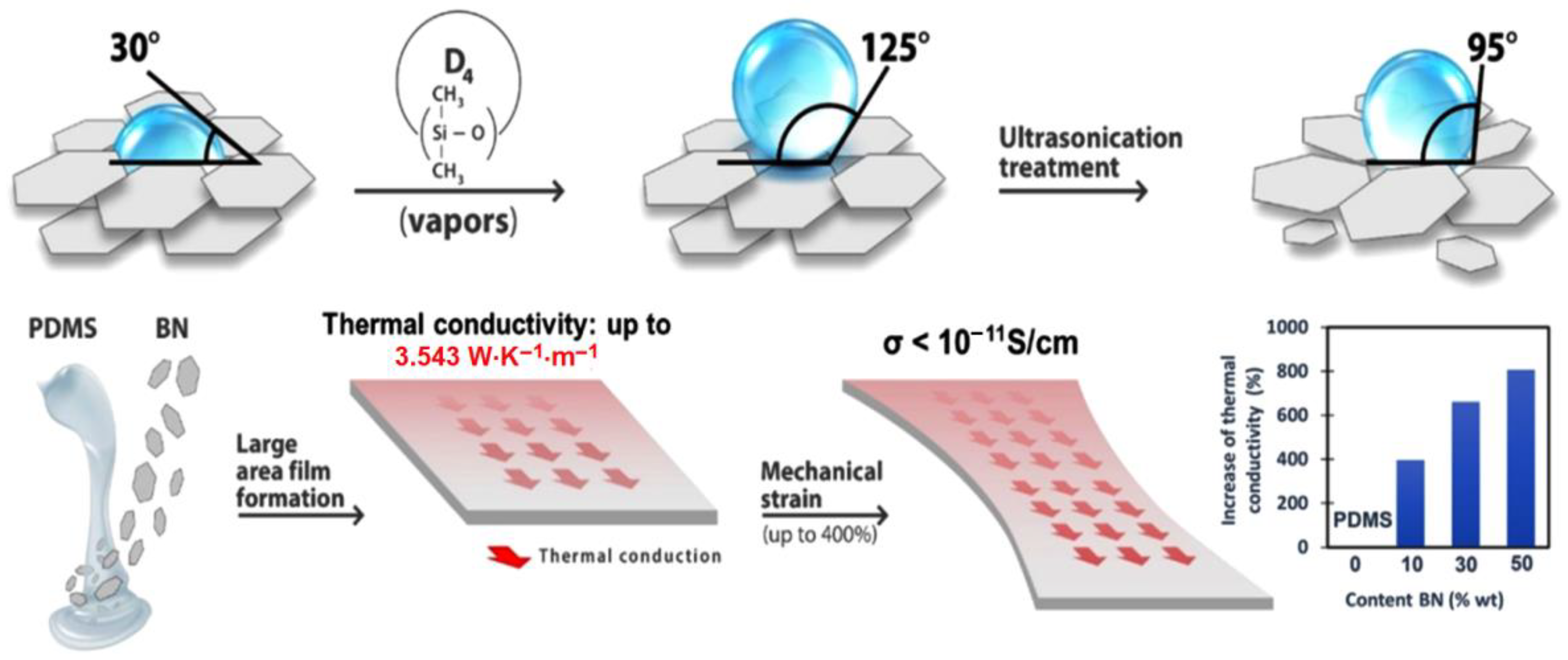
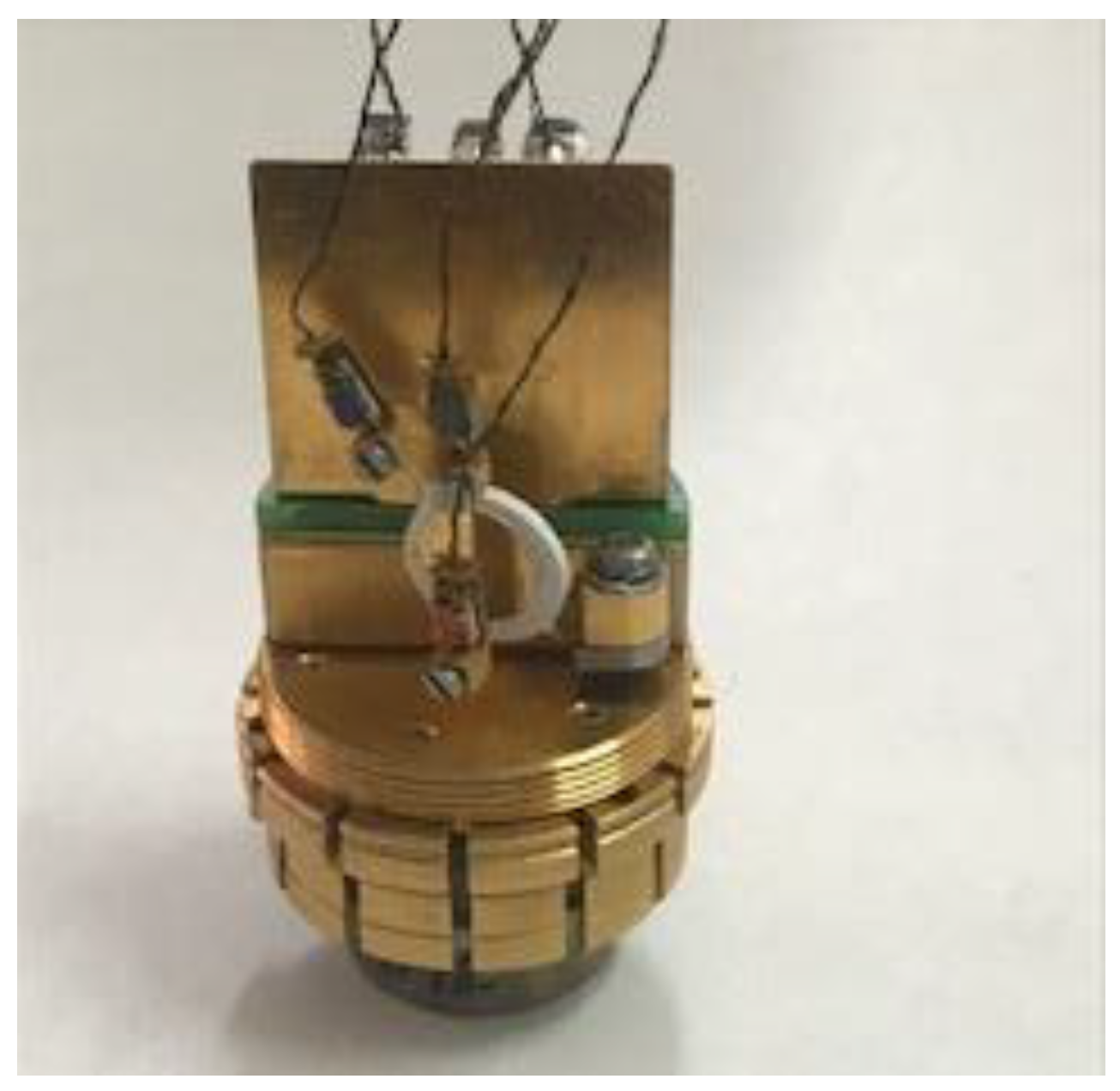
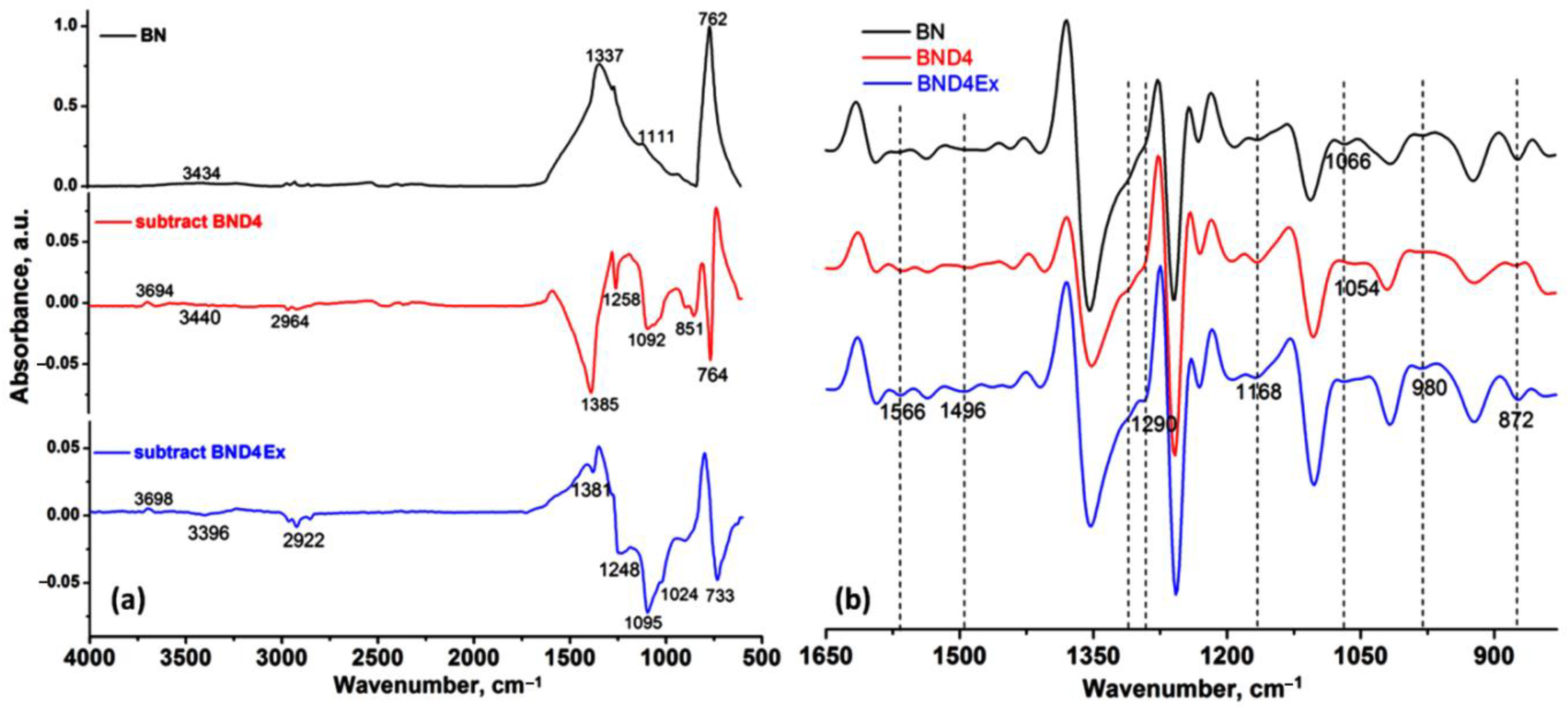
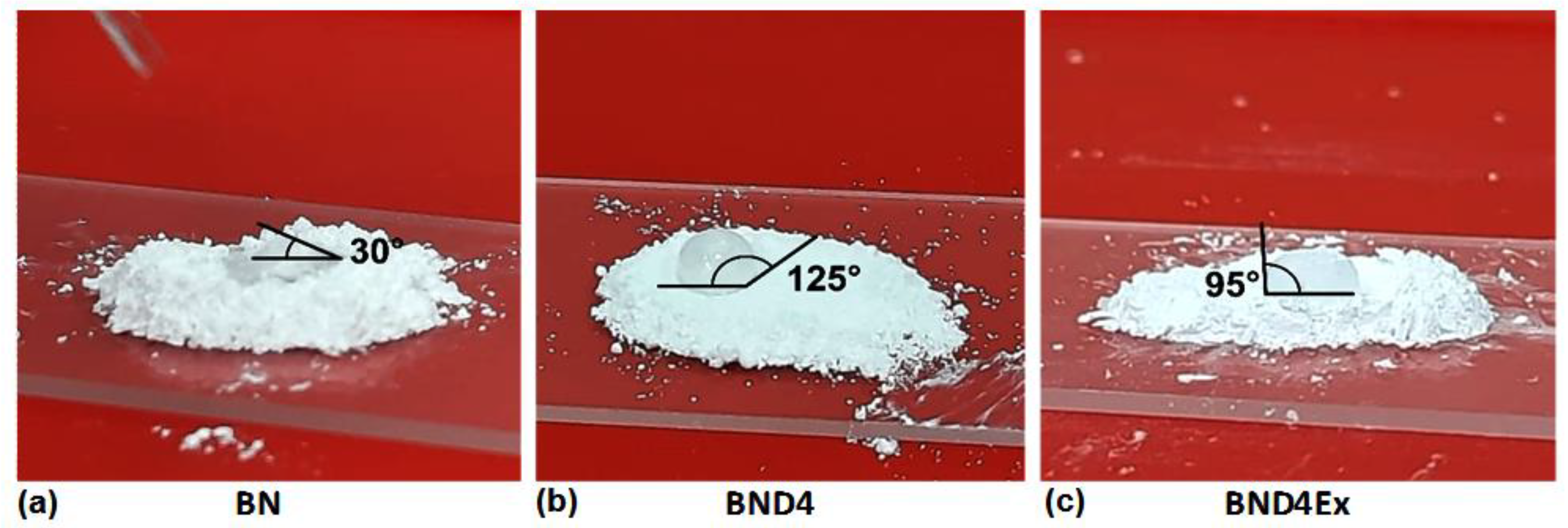

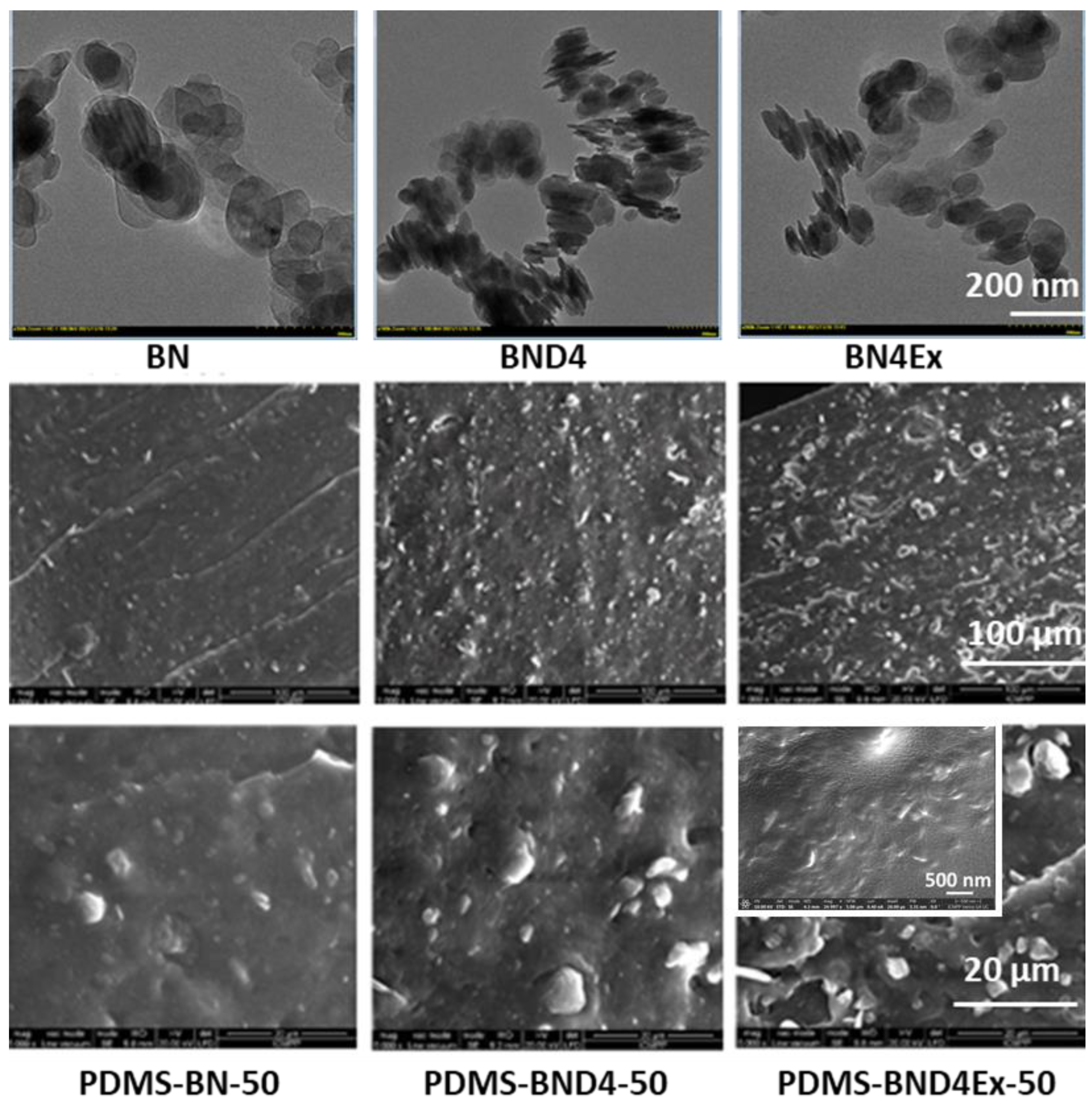
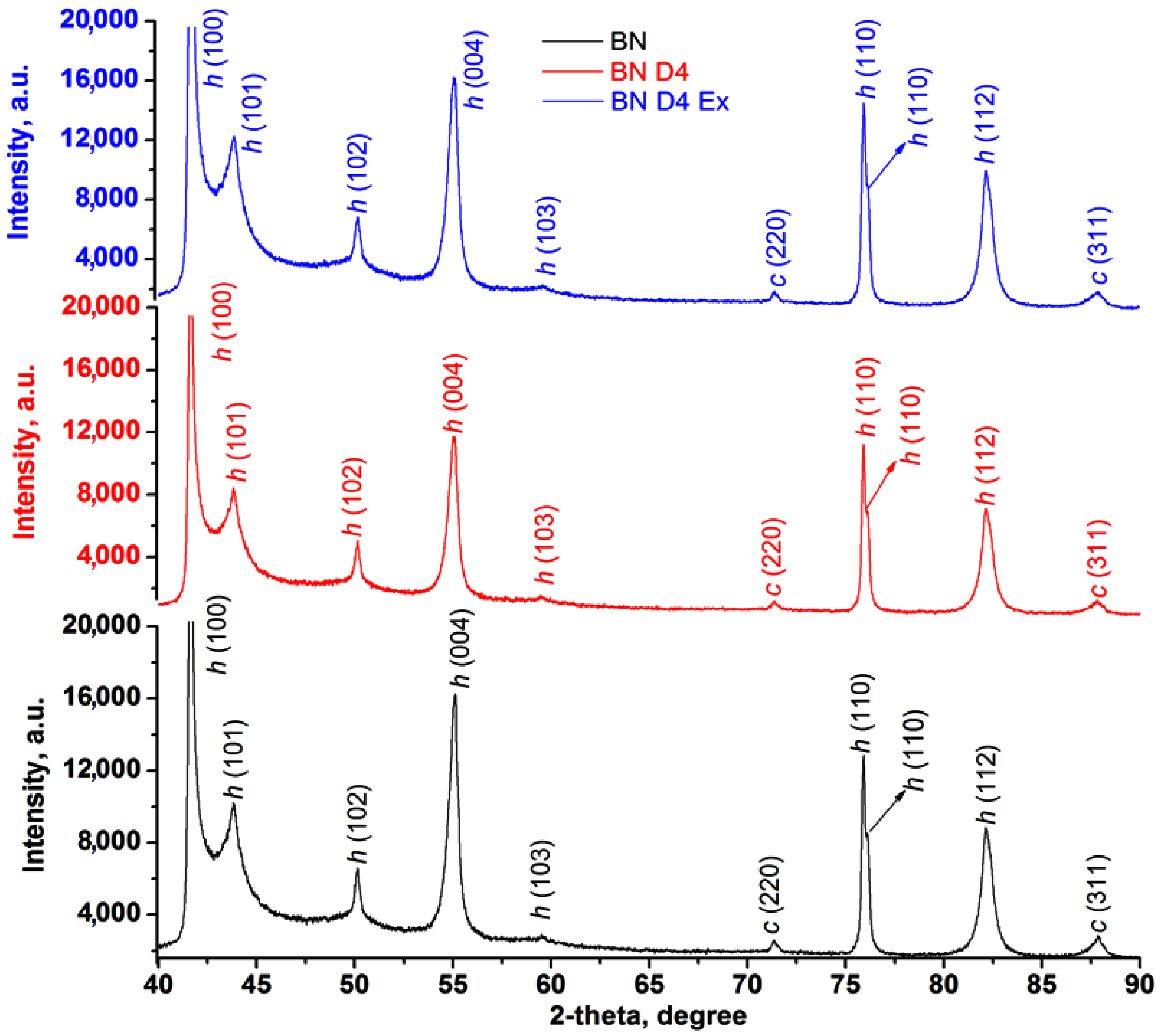
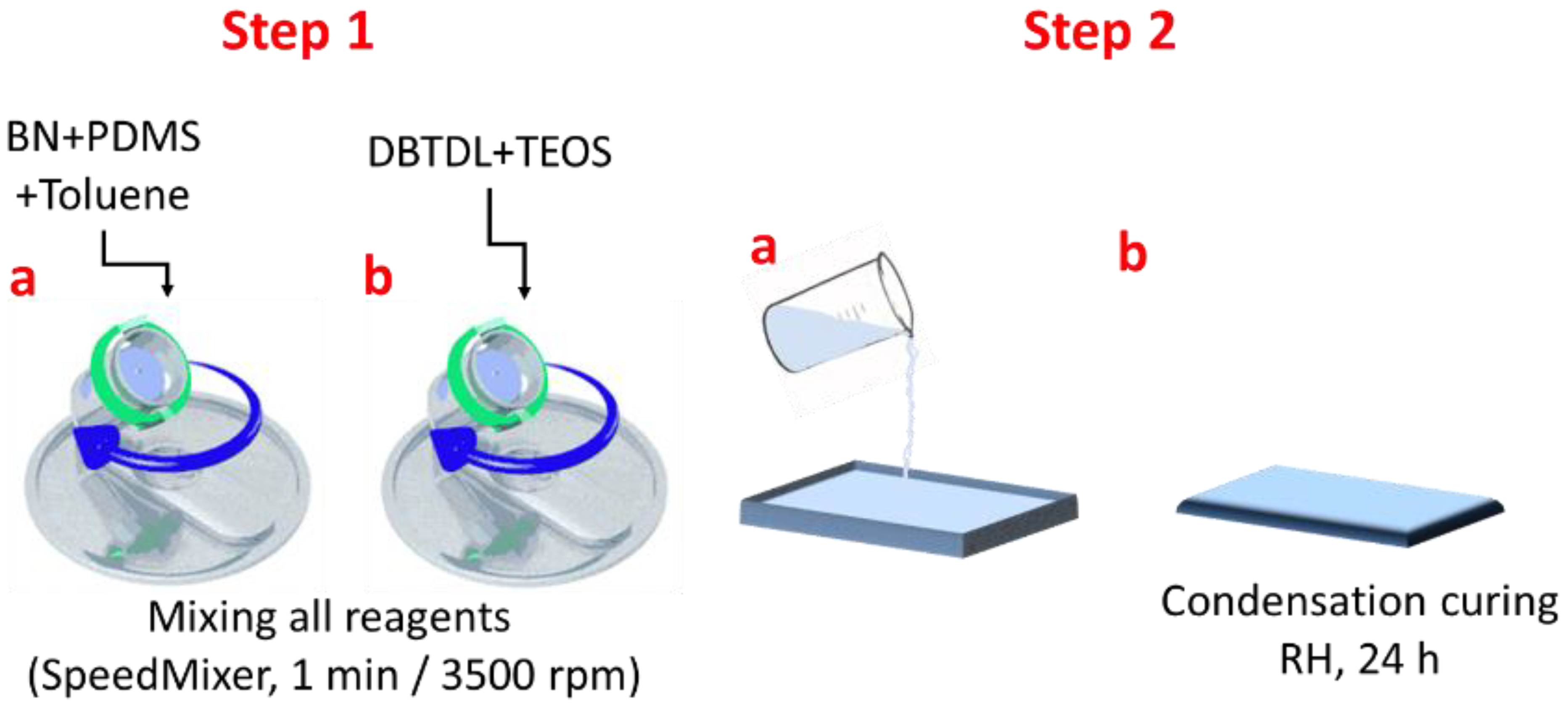


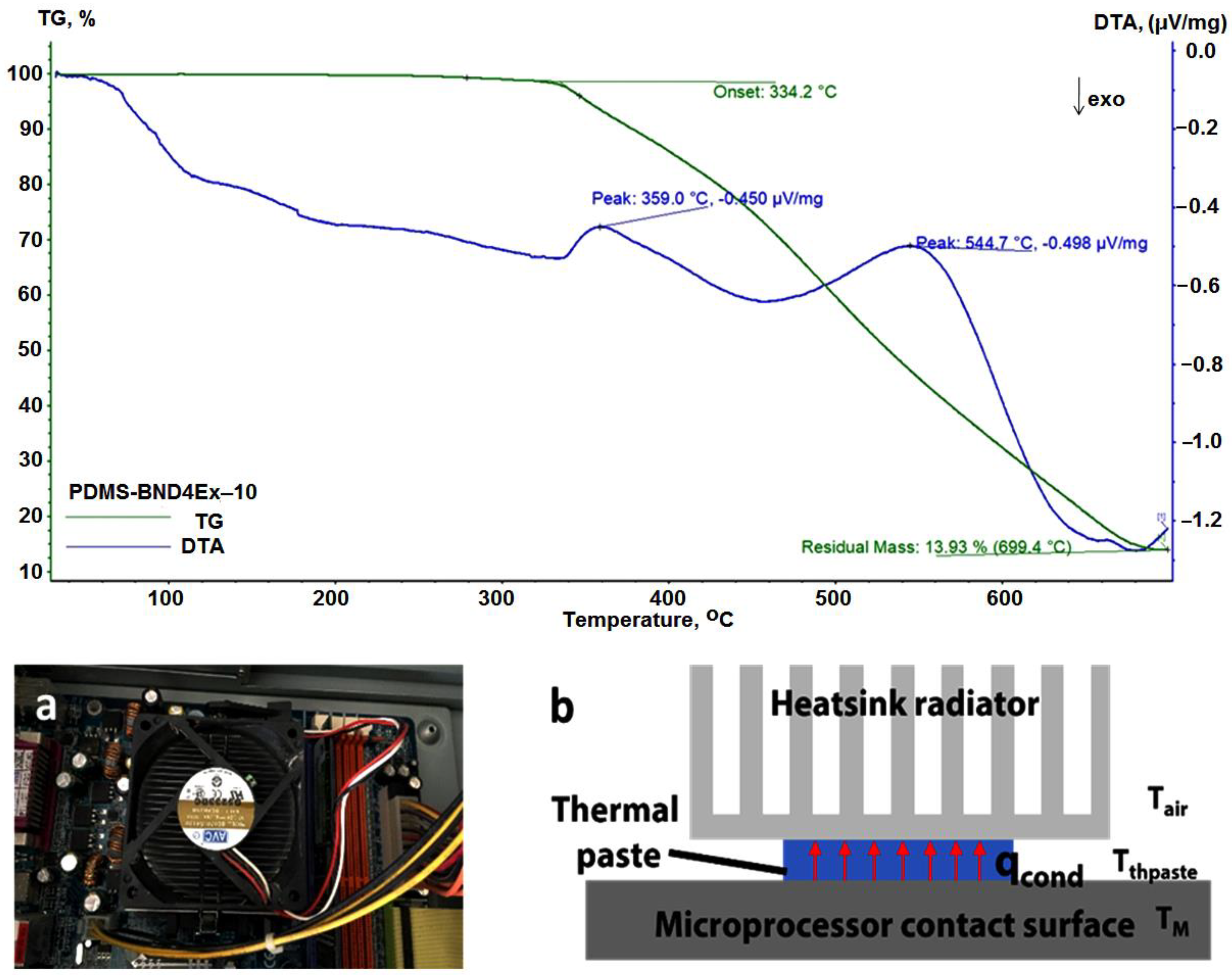

| Sample Labeling | PDMS, pph | BN, pph | DBTDL, wt% | TEOS, wt% | ||
|---|---|---|---|---|---|---|
| BN | BND4 | BND4Ex | ||||
| PDMS | 100 | - | - | - | 0.85 | 5.0 |
| PDMS-BN-10 | 90 | 10 | - | - | ||
| PDMS-BN-30 | 70 | 30 | - | |||
| PDMS-BN-50 | 50 | 50 | - | |||
| PDMS-BND4-10 | 90 | - | 10 | - | ||
| PDMS-BND4-30 | 70 | - | 30 | - | ||
| PDMS-BND4-50 | 50 | - | 50 | - | ||
| PDMS-BND4Ex-10 | 90 | - | - | 10 | ||
| PDMS-BND4Ex-30 | 70 | - | - | 30 | ||
| PDMS-BND4Ex-50 | 50 | - | - | 50 | ||
| Sample | Mechanical Data (ASTM D 412-06a) | Dielectrical Data (at 1 Hz) | UTT h | |||||
|---|---|---|---|---|---|---|---|---|
| Sm a, % | Y b, MPa | Tnm c, MPa | εr d | Ε″ e | Σ f, S/cm | Cp g, F | kJ/m3 | |
| PDMS | 213 | 0.24 | 0.22 | 3 | 0.25024 | 1.04 × 10−13 | 8.15 × 10−12 | 3.0 |
| PDMS-BN-10 | 135 | 0.4 | 0.23 | 4.2 | 0.04638 | 2.63 × 10−14 | 6.08 × 10−12 | 1.8 |
| PDMS-BN-30 | 270 | 0.7 | 1.02 | 4.1 | 0.18628 | 1.06 × 10−13 | 6.82 × 10−12 | 13.5 |
| PDMS-BN-50 | 245 | 0.81 | 0.8 | 4.4 | 0.05216 | 2.96 × 10−14 | 6.21 × 10−12 | 10.7 |
| PDMS-BND4-10 | 250 | 0.25 | 0.52 | 5.1 | 0.00277 | 1.38 × 10−11 | 4.81 × 10−12 | 4.5 |
| PDMS-BND4-30 | 240 | 0.88 | 95 | 4.8 | 0.00123 | 6.18 × 10−12 | 7.85 × 10−12 | 11.5 |
| PDMS-BND4-50 | 260 | 1.16 | 1.24 | 4.6 | 0.05072 | 2.88 × 10−14 | 7.84 × 10−12 | 16.5 |
| PDMS-BND4Ex-10 | 370 | 0.38 | 0.6 | 3.8 | 6.88 × 10−4 | 3.44 × 10−12 | 9.47 × 10−12 | 11.3 |
| PDMS-BND4Ex-30 | 400 | 0.7 | 1.23 | 3.8 | 4.65 × 10−4 | 2.33 × 10−12 | 7.73 × 10−12 | 24.3 |
| PDMS-BND4Ex-50 | 400 | 1.14 | 1.53 | 3.6 | 0.00234 | 1.17 × 10−11 | 7.51 × 10−12 | 33.0 |
| Composite Sample | Thermal Conductivity, W·K−1·m−1 | Conductance, W·K−1 | Reference |
|---|---|---|---|
| PDMS | 0.082 | This study | |
| PDMS-BN-10 | 1.887 | 0.012 | This study |
| PDMS-BN-30 | 2.062 | 0.013 | |
| PDMS-BN-50 | 2.753 | 0.018 | |
| PDMS-BND4-10 | 1.091 | 0.007 | This study |
| PDMS-BND4-30 | 1.675 | 0.011 | |
| PDMS-BND4-50 | 1.994 | 0.013 | |
| PDMS-BND4Ex-10 | 3.543 | 0.023 | This study |
| PDMS-BND4Ex-30 | 2.259 | 0.014 | |
| PDMS-BND4Ex-50 | 2.018 | 0.013 | |
| CPCM * | 1.968 | - | [13] |
| SCPCM ** | 2.899 | - | [13] |
Publisher’s Note: MDPI stays neutral with regard to jurisdictional claims in published maps and institutional affiliations. |
© 2022 by the authors. Licensee MDPI, Basel, Switzerland. This article is an open access article distributed under the terms and conditions of the Creative Commons Attribution (CC BY) license (https://creativecommons.org/licenses/by/4.0/).
Share and Cite
Stiubianu, G.-T.; Bele, A.; Grigoras, M.; Tugui, C.; Ciubotaru, B.-I.; Zaltariov, M.-F.; Borza, F.; Bujoreanu, L.-G.; Cazacu, M. Scalable Silicone Composites for Thermal Management in Flexible Stretchable Electronics. Batteries 2022, 8, 95. https://doi.org/10.3390/batteries8080095
Stiubianu G-T, Bele A, Grigoras M, Tugui C, Ciubotaru B-I, Zaltariov M-F, Borza F, Bujoreanu L-G, Cazacu M. Scalable Silicone Composites for Thermal Management in Flexible Stretchable Electronics. Batteries. 2022; 8(8):95. https://doi.org/10.3390/batteries8080095
Chicago/Turabian StyleStiubianu, George-Theodor, Adrian Bele, Marian Grigoras, Codrin Tugui, Bianca-Iulia Ciubotaru, Mirela-Fernanda Zaltariov, Firuța Borza, Leandru-Gheorghe Bujoreanu, and Maria Cazacu. 2022. "Scalable Silicone Composites for Thermal Management in Flexible Stretchable Electronics" Batteries 8, no. 8: 95. https://doi.org/10.3390/batteries8080095







